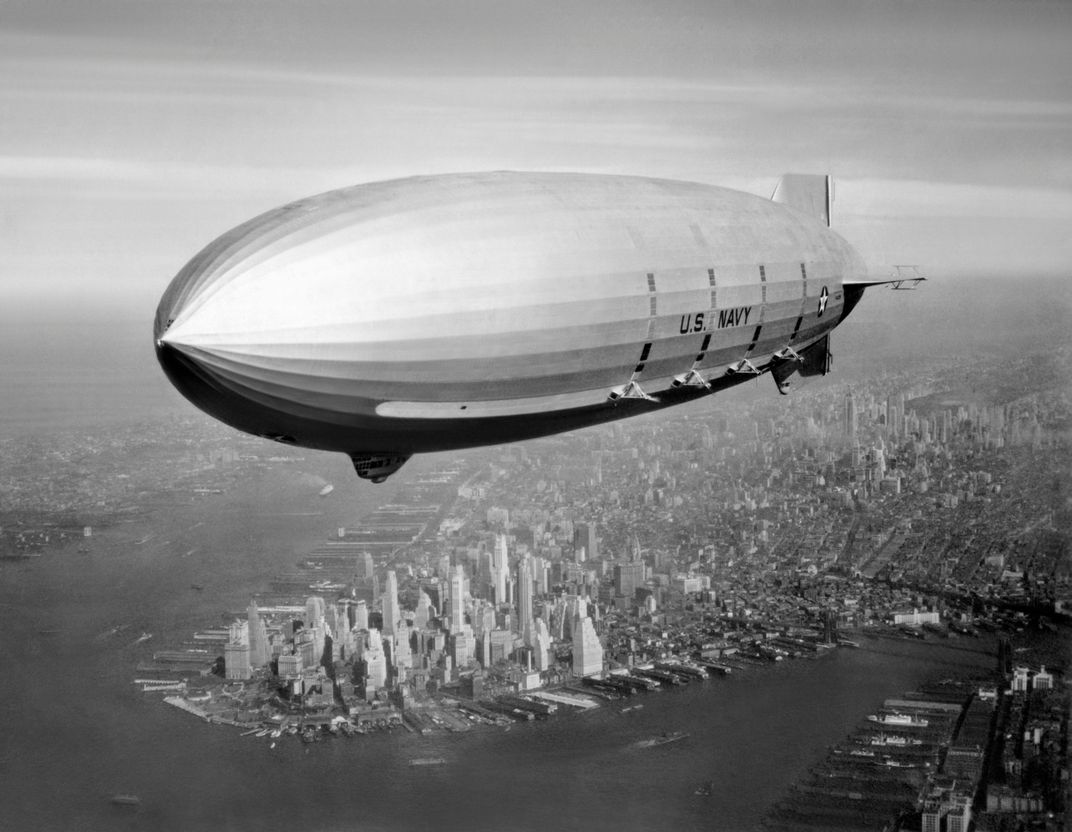An Airborne Drone Center is Now on the Amazon Wishlist
The online retail giant re-inflates an old idea.
/https://tf-cmsv2-smithsonianmag-media.s3.amazonaws.com/filer/f7/3a/f73a9a66-7767-4177-b0b3-f2990e934eef/34d_am2017_blueprint_live.jpg)
Amazon has designed a giant airship to deliver packages. Could it become the cheapest and fastest way to get consumers their goods?
An enormous airship hovers eight miles above the city, its cavernous interior filled with consumer goods. Small drones spill out from it like candy from a piñata, delivering orders all over the city within minutes of customers’ placing them. The idea of a giant, floating drone-mothership seems unrealistic, but global retail behemoth Amazon seems to believe it realistic enough: The company filed a patent last year to do just that. It’s just one of several forward-thinking concepts the company may pursue in using drones to close the “last mile” delivery gap.
The patent, straightforwardly titled “Airborne fulfillment center utilizing unmanned aerial vehicles for item delivery,” went unnoticed until retail analyst Zoe Leavitt mentioned it on her Twitter feed (@Zoe_Leavitt). The patent is short on details, but it paints a picture of an “aerial fulfillment center,” basically a floating warehouse kept aloft by helium or hot air, which would hover at roughly 45,000 feet above sea level, above almost all commercial and civil aviation. The warehouse would, upon demand, deploy winged drones that would glide unpowered until approaching a delivery target; on approach, motor-driven propellers would slow them. (The target itself is the subject of another patent; it may transmit radio signals.) After delivery, the drones fly to a “shuttle replenishment area,” from which a smaller airship will eventually carry them, along with supplies and possibly workers, back to the floating warehouse. This is one concept that would fulfill Amazon’s vision of dropping things on us minutes after we order them. The online retailer has dreamed up a few others: Small drones that stop to recharge at lampposts, as the company described in another patent, or bigger ones delivering from the warehouse to a central zip code distribution point, where automated vehicles would take over. One trial is ongoing, though limited to a handful of people living a short distance from one big warehouse near Cambridge, England: Participants order online, place small landing pads with machine-recognizable patterns in their yards, and within half an hour a quadrotor delivers their orders, then returns to base. Eventually, Amazon hopes, the company will replace the delivery companies that now make those last-mile deliveries (UPS, FedEx, etc.). Doing away with those services could reduce shipping costs significantly.

Although Amazon did not respond to requests for clarification of the concept, we can assume the company sees this delivery system as a potential cost saver. “Because [airships are] lighter than air, they don’t require fuel to stay aloft like other aircraft,” says Dan Grossman, founder of airships.net, a website dedicated to famous airships, most of which are from the early 20th century (when people believed they could dominate the future of aviation). Airships achieve lift through the buoyancy of the gas in their envelopes, rather than through high-speed air moving past a wing. Any fuel they carry is used to move forward instead of just staying airborne. As a result, “airships are good at staying aloft for a long period of time, or traveling long distances without burning a lot of fuel,” Grossman says.
But to carry any meaningful weight, airships must be really, really large. Unfortunately, the largest airship ever built could carry only around 100 people, and that same craft effectively ended the first era of airships. Though the risk of an explosion like the 1937 one that immolated the Hindenburg is all but gone—blimps and balloons flying today rise using either hot air or nonreactive helium—the Zeppelin became so infamous that 80 years later people are still leery of flying on airships.
Amazon’s airship would carry mostly stuff, but along with robots, humans would be on board to operate forklifts in the pressurized warehouse. Such an airship would need to be much larger than the Hindenburg, particularly to float to the ambitious altitude of 45,000 feet.
Should Amazon actually proceed with its patented plans, these airships won’t be the first to launch other aircraft. In the early 1930s the U.S. Navy developed and deployed two airships, the USS Akron and the USS Macon, which each carried four Curtiss Sparrowhawk biplanes. Though both the Macon and the Akron demonstrated the “parasite fighter” concept, it wasn’t long before both airships crashed and the program was canceled.
After the Hindenburg disaster, airships lost popularity, but the idea still comes up every now and again, mostly for carrying massive loads into remote areas—the intent of both Hybrid Air Vehicles’ Airlander 10, currently in flight testing in the United Kingdom, and Lockheed Martin’s LMH‑1. The technology demonstrator for the LMH-1 first flew in 2006. (Neither airship has yet secured an order.) So technologically, the concept is sound. The big question is whether this plan is really the cheapest way to get goods to consumers.
Airship expert Grossman says that a floating warehouse could dispatch gliding drones up to 20 miles, but Amazon already has warehouses in major urban areas, and assuming drone deliveries from those places become widespread, the energy saved by gliding from high altitude probably doesn’t outweigh the cost. But Grossman also emphasizes the most important use of airships today: advertising. As companies that fly blimps over football games know, advertising services or goods on a giant, mobile billboard is a great way to reach large audiences. Just imagine the public relations and marketing value of a huge floating warehouse—one that’s emblazoned “Amazon.com”—deploying the latest bestsellers and other goods. It may not be economically practical, but it would certainly be a sight to behold.
/https://tf-cmsv2-smithsonianmag-media.s3.amazonaws.com/accounts/headshot/ED_DARACK.jpg)

/https://tf-cmsv2-smithsonianmag-media.s3.amazonaws.com/accounts/headshot/ED_DARACK.jpg)